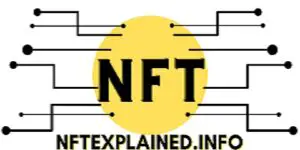NFTs or non-fungible tokens are unique one-of-one digital assets that allow the holder to verify they own the asset via blockchain technology; NFTs also allow you to see the previous transactions/owners as the blockchain is immutable.
NFTexplained.info is a team of long term crypto investors. In this article we will dissect the answer to: are NFTs based on Ethereum? Let’s dive in.
NFTs allow someone to prove they own a digital item and are based on smart contracts which have been made possible via blockchain technology. NFTs are most frequently minted on the Ethereum network but can also be minted on other blockchains that support smart contracts and 1 of 1 token standards like $SOL and $ADA.
While the vast majority of NFT transactions happen on Ethereum, NFTs are not completely based on Ethereum. NFTs have been made possible because they store extra information related to the unique token standard that is known as an NFT.
NFTs are non-fungible, meaning each one is unique and can not be substituted the same way one Ethereum can be exchanged for another Ethreum (at the same point in time as they would hold the exact same value).
Ethereum-based NFTs have become the most popular because of the network’s security and the ERC-721 token standard which describes ownership of an NFT; this token standard is built on the Ethereum Virtual Machine (EVM). The creation of ERC-721 is what began the NFT craze and in particular CryptoKitties.
To learn about the history and the earliest NFTs, click here.
Following the ERC-721 token standard – what the vast majority of NFTs are based on – came the ERC-1155 token standard. ERC-1155 is the token standard which is most similar to that of Solanas’. ERC-1155 tokens allow the changing of metadata whereas ERC-721 only supports static metadata which is stored directly in the smart contract. This increase in flexibility makes it highly probable that more NFTs will be based on this newer, ERC-1155 token standard.
ERC-1155 also allows for semi fungible tokens. A semi fungible token is a token which first starts like an ERC-20 token which is fungible (i.e. $ETH, $XRP, $ADA, etc.) but then turns into a non-fungible token.
An illustrative example of this is an NFT, which holds utility that is access to a real world event. Before the token has granted you access into the event, it is semi fungible as each one is the same before the event starts. Once the event starts, the token becomes non-fungible. This is an illustration of what ERC-1155 token standard enables.
This moves NFTexplained.info into our next section of the article.
Are Most NFTs Based On Ethereum?
As a general statement, the vast majority of NFT transaction happen on the Ethereum blockchain because of its security and ease of use. It is estimated that approximately 80% of NFT transactions happen on the Ethereum blockchain.
The team at NFTexplained.info think other blockchains (i.e. Solana), which are currently much smaller, will continue to see increases in transaction volume as people look to avoid high miner fees.
Why Are NFTs (Largely) Based On Ethereum?
NFTs are primarily based on Ethereum because of the provenance they allow for as well as the smart contract capability the blockchain provides. NFTs are also possible on other smart contract related blockchains like Solana as they also allow for token standards that are unique.
Ethereum has seen the most transaction volume because of the ease developers enjoy building atop the blockchain. Its development for Dapps or decentralized applications make it attractive to those looking to create blockchain related games.
Since NFTs have provenance and metadata attached to the smart contract, when the NFT is minted, they make for a new medium that is attractive to many creators and remove the need for intermediaries. Provenance means the previous transaction can be seen, which therefore makes it that much harder to fake authenticity.
Recently, other blockchains have become more attractive to investors due to lower gas fees. Solana – amongst others – has seen massive increases in transaction volume and the largest NFT marketplace, OpenSea, has begun integrating Solana NFTs.
Solana works using a proof of history blockchain consensus algorithm as opposed to the Ethereum current proof of work (however, planning is underway to move to proof of stake) blockchain consensus algorithm. This is the main reason as to why Solano offers lower gas fees.
The NFT space is always changing and the technology is quite new. Our team is incredibly excited to see what will happen as time passes. To get the latest news in this rapidly evolving space, follow our team on Instagram & Twitter!
If you would like to support our team’s content creations you can join us and:
Trade stocks & crypto on Webull – get 2 free stocks!
Buy a Ledger hardware wallet!
U.S. users can get a crypto trading discount on Binance!

